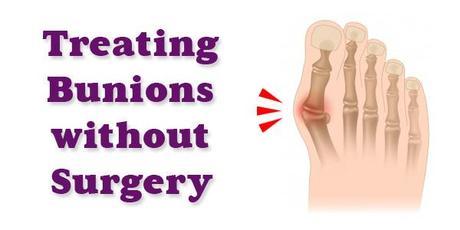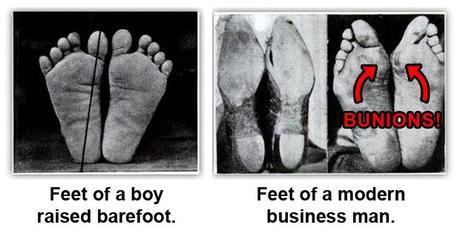
Do you suffer from bunion pain? Have you been told that surgery was your only option for relief? If so, then we may have some good news for you: a podiatrist in Portland believes gentler, simpler options may be available.
Dr. Ray McClanahan is a leader in conservative foot care treatments and believes that most foot ailments can be prevented and/or treated be restoring natural function (i.e., barefoot-like movement). He is also the inventor of Correct Toes—simple, over-the-counter toe spacers that may help treat a wealth of foot problems.
What is a Bunion?

When did this become trendy?
What Causes Bunions?
While many factors may increase your chances of developing bunions, including arthritis, limb length inequalities and genetics, McClanahan believes conventional shoes that make women's feet look small and pointy may be the prime culprit. Fashionable women's shoes (and some men's shoes) tend to have tapered toe boxes, which push big toes inward. Raised heels and arch supports, also popular among conventional shoes, may also contribute to the development of bunions. Wearing these kinds of shoes for many years can lead to deformity in the feet, in which the big toe literally stays bent growing toward the second toe. When this happens, the point where the bunion occurs continues to protrude further. In cultures of people who routinely go barefoot, toes are usually the widest part of feet and bunions are extremely rare. In our western culture, however, the ball of the foot is commonly the widest point and bunions, located right at that spot, are quite common.

Treatment Options
A conventional treatment for a bunion is a bunionectomy, or surgery that removes part of the bulging metatarsal bone and forcibly realigns the joints. This surgery is often followed with prescriptions for orthotic arch supports and highly cushioned shoes that keep feet confined in unnatural positions. While this may result in some pain relief, proponents of natural foot movement argue that the surgery does not confront the source of the issue and may be an extreme solution when other, less invasive options may be available. It's worth noting that bunions can still return after surgery, especially if the conditions that caused them in the first place have not changed.
Natural Bunion Treatment
McClanahan practices an alternative way to treat many bunion patients with less invasive measures, essentially by gently restoring the natural shape and function of the foot. It's really quite simple:
- With the use of bunion splints or toe spacers (such as Correct Toes—McClanahan's own invention) toes can be gradually restored to a more natural position, thereby undoing the motion that pushes the bunion out.
- Simple massage and range of motion exercises, like the one shown in the video below, can be very effective in relaxing and "retraining" foot muscles to move toes in their natural direction.
- Wearing footwear that encourages natural movement is strongly recommended to reverse, rather than encourage, the damage.
Bunion-Fighting Footwear
So what kind of shoes should you look for? McClahahan recommends finding shoes with the following features:
- Wide toe boxes that allow your feet to spread.
- Little or no arch support.
- Little or no elevated heels.
- Overall lightweight and flexible design.
Fortunately, many shoe manufacturers have begun making minimalist shoes that meet these criteria, including... [ahem]... Soft Star Shoes! Every one of our shoes are designed to keep your feet as barefoot as possible with wide toe boxes and thin, flexible heels. We are proud to say we have a wide selection of fashionable women's shoes to keep your feet moving naturally... all made by hand in Oregon, USA!

Who says stylish shoes have to hurt your feet?
We hear from many happy customers who have worn our shoes to help reverse bunion pain and find relief. Please remember that we are shoemakers, not doctors, so we can't make any medical claims about our footwear and we don't prescribe our shoes for any treatment routine—nor do we guarantee any results. That being said, we have heard many customer success stories and we hope you'll give us a try if you're trying to recover from bunion pain.
The earlier a bunion is treated, the more likely it can be relieved. McClanahan also warns that the longer feet are deformed by tapered shoes, the less effective treatment will be. In severe cases, surgery may end up being the only option. It is worth noting, however, that many traditional podiatrists shun the idea of treating and curing foot pain by restoring natural movement simply because these methods are relatively new and challenge traditional thinking. If you are interested in seeking alternative treatment or getting another opinion based on natural foot function, then you may have to do your work finding a podiatrist who supports this view.
For more information about Dr. Ray McClanahan and his practice, visit the Northwest Foot and Ankle Website. We also recommend these articles:
- "Bunions and Hammertoes" by Dr. Ray McClanahan
- Bunion Causes and Symptoms by Dr. Ray McClahahan
Watch this video to see Dr. McClanahan explain bunion causes and treatment options in more detail:
Related Posts:
- Do You Have Pain in the Ball of Your Foot? How to Diagnose and Treat Capsulitis
- Are High Heels Giving You Hammer Toes? Tips for Prevention and Treatment
- The Mighty Arch: A Natural Cure for Plantar Fasciitis?

